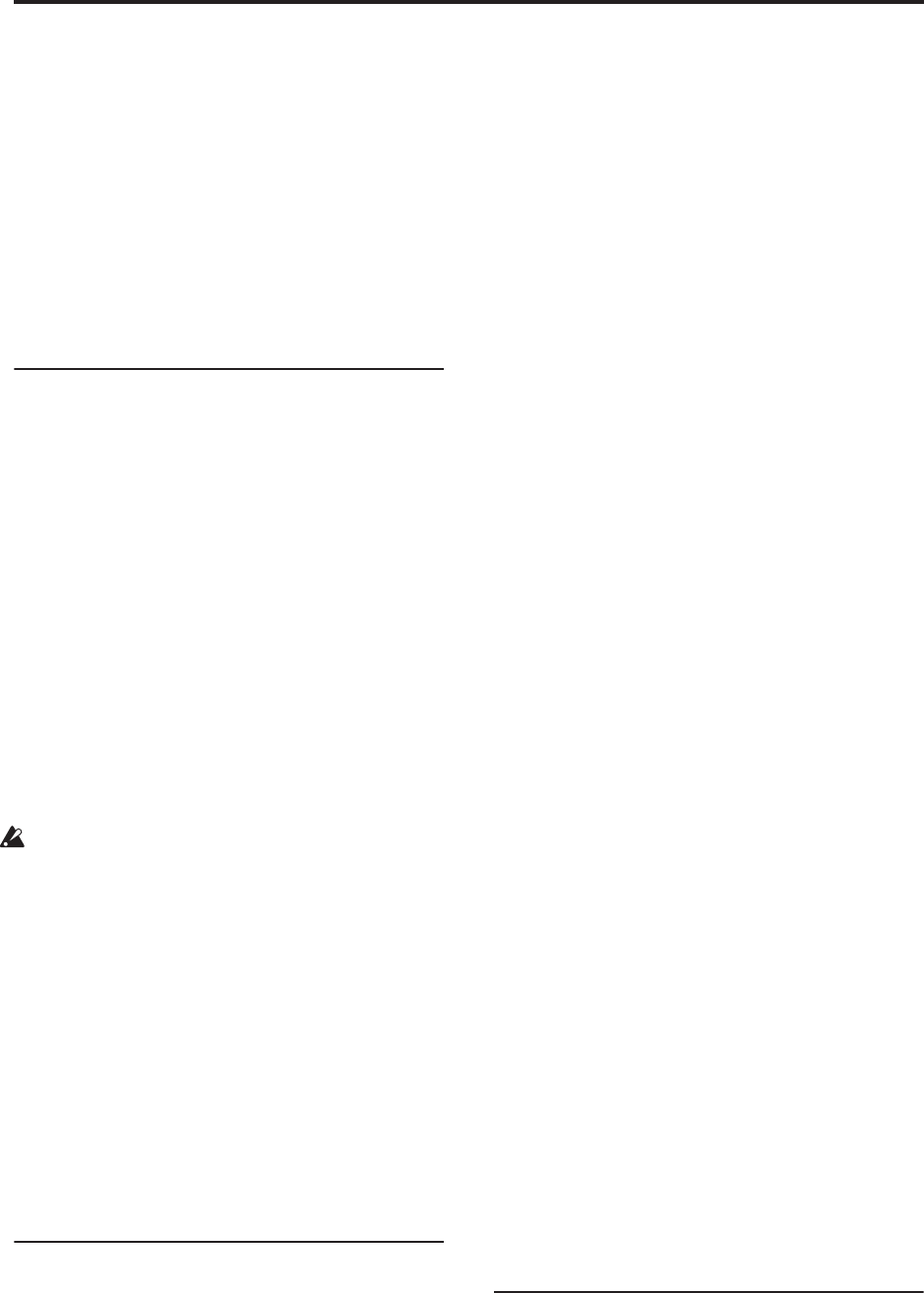
Appendices
1008
Note: In Program mode, the corresponding program
parameters will be temporarily edited by these
messages. You can Write the program to save the
modified state (except for certain parameters). The
Write operation can also be performed by a MIDI
System Exclusive Program Write Request message, in
addition to the usual method of using the OASYS’s
switches. When you write the data, the values of the
corresponding program parameters will be rewritten.
Note: The results of receiving these messages will
depend on the instrument. The operation may be
different when a device other than the OASYS is
connected.
Vector control
If you assign the following CC#s to the X-axis and Y-
axis of the vector joystick, the specified CC# will be
transmitted when you operate the OASYS, and the
OASYS itself will be controlled simultaneously. When
this message is received, the result will be the same as
if you operated the OASYS itself.
You can use this to record vector joystick operations on
the internal sequencer or an external MIDI sequencer,
or to control the vector joystick from an external MIDI
device.
The CC# settings for the vector joystick are made in the
Global P2– Controller page. Although you can select
any MIDI control change CC#00–CC#119 for the
vector joystick, you will normally use the default
settings that are assigned when you execute the page
menu command “Reset Controller MIDI Assign” with
Default Setting. For more information, see “Reset
Controller MIDI Assign” on page 687.
These messages are transmitted and received if
Global “MIDI Vector MIDI Out” is set to Vector
Joystick. If Global “MIDI Vector MIDI Out” is set to
Vector CC Control, the CC# specified for Vector CC
Control in each program, combination, or song will
be transmitted. Normally you will use the Vector
Joystick setting.
The operations described below are for these default
settings.
Vector joystick X (CC#118) [Bn, 76, vv]
Vector joystick Y (CC#119) [Bn, 77, vv]
When you move the OASYS’ vector joystick in the X
direction, vector joystick X will be transmitted (vv:
00:left…7F:right). When you move it in the Y direction,
vector joystick Y will be transmitted (vv: 00:toward
yourself…7F:away). The same result will occur when
these messages are received.
KARMA function control
If you assign the following CC#s to the KARMA
CONTROLS sliders and switches, the specified CC#
will be transmitted when you operate the OASYS, and
the OASYS itself will be controlled simultaneously.
When these messages are received, the result will be
the same as if you operated the OASYS itself.
The CC# settings for each knob and switch are made in
the Global P2– Controller page. Normally you will
leave these Off. However, you can use these settings if
you need to assign MIDI control change messages to
these controllers, such as when you want to record the
operations of the KARMA CONTROLS sliders and
switches on the internal sequencer or an external MIDI
sequencer, or to control the KARMA function from an
external MIDI device.
Although you can select any MIDI control change
CC#00–CC#119 for each slider and switch, you will
normally use the default settings that are assigned
when you execute the page menu command “Reset
Controller MIDI Assign” with CC Default. For more
information, see “Reset Controller MIDI Assign” on
page 687.
The operations described below are for these CC
Default settings. The messages will be transmitted
when you operate the corresponding controller of the
OASYS. When these messages are received, the result
will be the same as if you operated the controller on
the OASYS itself.
KARMA ON/OFF (CC#14) [Bn, 0E, vv]
This corresponds to the KARMA ON/OFF switch. It
transmits vv=127 [F7] when turned on, or vv=127 [7F]
when turned off.
KARMA Slider1 (CC#22) [Bn, 16, vv]
KARMA Slider2 (CC#23) [Bn, 17, vv]
KARMA Slider3 (CC#24) [Bn, 18, vv]
KARMA Slider4 (CC#25) [Bn, 19, vv]
KARMA Slider5 (CC#26) [Bn, 1A, vv]
KARMA Slider6 (CC#27) [Bn, 1B, vv]
KARMA Slider7 (CC#28) [Bn, 1C, vv]
KARMA Slider8 (CC#29) [Bn, 1D, vv]
These correspond to KARMA CONTROLS sliders 1–8.
KARMA SCENE (CC#30) [Bn,m 1E, vv]
This corresponds to the KARMA SCENE switches.
(vv” value; 00: Scene 1, 01: Scene 2, 02: Scene 3, 03:
Scene 4, 04: Scene 5, 05: Scene 6, 06: Scene 7, 07: Scene 8,
08…7F: invalid)
KARMA LATCH (CC#31) [Bn, 1F, vv]
This corresponds to the KARMA LATCH switch. It
transmits vv=127 [7F] when turned on, or vv=127 [7F]
when turned off.
KARMA SW1 (CC#102) [Bn, 66, vv]
KARMA SW2 (CC#103) [Bn, 67, vv]
KARMA SW3 (CC#104) [Bn, 68, vv]
KARMA SW4 (CC#105) [Bn, 69, vv]
KARMA SW5 (CC#106) [Bn, 6A, vv]
KARMA SW6 (CC#107) [Bn, 6B, vv]
KARMA SW7 (CC#108) [Bn, 6C, vv]
KARMA SW8 (CC#109) [Bn, 6D, vv]
This corresponds to the KARMA SWITCH 1–8. It
transmits vv=127 [7F] when turned on, or vv=127 [7F]
when turned off.
Pad 1–8 control
If you assign the following CC#s to Pads 1–8, the
specified CC# will be transmitted when you operate
the OASYS, and the OASYS itself will be controlled
simultaneously. When these messages are received, the
result will be the same as if you operated the OASYS
itself.


















